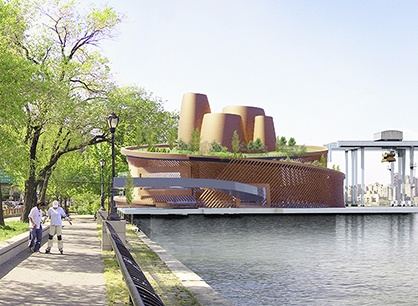Rethinking the Future (RTF), an organization “born from the idea of creating a new window on international trends in architecture and design that looks on to the solutions for the need of the era,” selected the winners of their new awards program, Global Architecture & Design Award. Focused on recognizing innovation in architecture and design that meets human needs while preserving the environment, we are proud to announce that our concept, “Plasma Power: Getting to Zero Waste in the New Millennium,” was chosen among 748 projects from over 50 countries in the Public Building Concept category.
Our concept employs architecture, design, and education to address the on-going challenge of reducing urban waste. Over the years, cities have developed solutions to the problem of waste disposal by recycling, composting, and converting garbage into alternate energy. While these measure offset some of the pollution, there is still more work that can be done. Our design creates a new municipal prototype that utilizes advancing technology by converting trash into a synthesis gas.
Integrated into the urban waterfront, the waste processing equipment is concentrated in a circular plan to minimize its footprint. A perforated mesh skin visually hides the truck ramp and conveyor areas, providing safety to visitors and restricting access of unauthorized personnel. Visitors may wander and explore the spiral walkway leading to the rooftop park. Here one can view the processing of waste in a series of “hives” enclosing the largest pieces of equipment. This new waste system is not only a benefit to the environment but also provides a new park to urban neighborhoods.
In the Global Architecture award, we explored how three cities could apply Plasma Power Technology:
- New York City. Today, only 25% of NYC’s solid waste is recycled or composted. To meet its Zero Waste goal in 2030, Plasma Plants will replace the City’s existing Five Marine Transfer Stations that now ship trash to landfills.
- Oslo. Norway is already a leader in waste to energy conversion and imports trash on the international market as source of fuel. A Plasma Plant on the Oslowaterfront will complement a conventional waste to energy operation in Klemetsrud, in the city suburbs.
- Tokyo Bay. Densely populated Japan has been a pioneer of trash based land creation in Tokyo and other port cities. A plasma plant on an existing artificial Island in the Tokyo Baywill be integrated into the Umi-No-Mori public park now under construction.
Entries were carefully evaluated across 30 different categories by a team of international experts from different facets of our industry. Check out the inspiring winning projects here!
“These projects demonstrate how design can make a positive impact on communities around the world. Each geographic place needs architects dedicated to understanding the challenges and opportunities latent in the physical world around them. The best of these designs tapped into this significant understanding of place and transformed the places to better connect, stimulate, and challenge the people around them.” –Juror, Sven Shockey | Vice President | Design Director | SmithGroup
